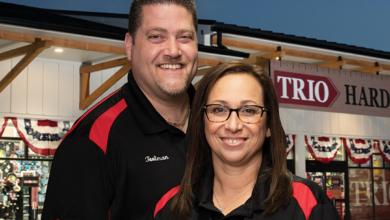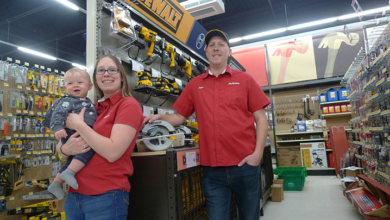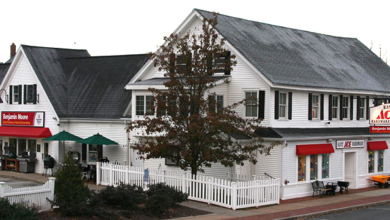Ready for the Next Century
By Chris Jensen

Kevin Boyd
Greschlers Hardware
Brooklyn, N.Y.
Even after a century, Century Club retailer Greschlers Hardware in Brooklyn, N.Y., is still finding ways to connect professional contractors with the services and supplies they need to be successful. The family-owned hardware store commemorated 100 years in business by spending most of 2019 undergoing a dramatic expansion. Several years ago, the Boyd family decided to purchase the surrounding buildings and expand the Do it Best store’s footprint. The mammoth project allowed Greschlers to better serve the local community of professional contractors while also making the front facade more welcoming to walk-in DIYers.
Now operated by third- and fourth-generation family members, Greschlers Hardware is a great example of an independent 100-year-old retail business unafraid to change, grow and reinvent itself to remain relevant. The bold decision to expand, in an area where land and construction costs are some of the highest in the nation, demonstrates the Boyd family’s deep commitment to their customers.
We interviewed Kevin Boyd, the patriarch of the business, about how the expansion project has prepared Greschlers Hardware for a new century of service.
What is the history of the business?
Greschlers Hardware was started by two brothers, Ed and George Greschler, in 1919. The business was then passed down to Ed’s son, Jerry, who ran it until 1999, when I (Jerry’s stepson) bought the business. I bought the building in 2001. My three sons—Greg, Michael and Matt—entered the business as they graduated from college. The bulk of the workload is now carried by my three sons, as I enjoy semi-retirement. I come in three days a week and help out on projects.

How has the business evolved over the past century?
Greschlers started out as a neighborhood hardware store. Its close proximity to the Brooklyn Navy Yard and docks offered a great opportunity to expand into the marine business. Jerry’s entry into the business found them doing more business with manufacturers, commercial and government agencies. That was a choice that proved beneficial, as the marine business declined due to high labor cost for dock workers.
My entry into the business added the contractor trades. In the 1990s, much of the manufacturing left Brooklyn due to high real estate taxes. Leaving a large void, it was later filled by the contractor trades. When Greg, Michael and Matt entered they expanded into internet sales.
What is your customer mix today?
The in-store business is divided 76% contractors, 7% commercial, 7% industry, 5% government and 5% local retail. Our internet sales account for 15% of our total gross sales. Our store hours reflect our customer base. We are open Monday through Friday 6:30 to 4:30, Saturday is 7:30-12:15 and closed Sunday.
I love my customers. I’ve been dealing with the same people for 40 years. Now we’re dealing with the sons and they remember when I gave them trinkets. People come to you with all their problems and you give them the solution.

What are your top-selling departments?
Our dominant departments are fasteners, cutting/drilling, hand tools and hardware—each account for about 11% of sales. We wish to expand safety to also make it a dominant department.
What local competition do you face?
We have a Home Depot three blocks away and a Lowe’s about 12 blocks away. Also within a 12-block radius we have Fastenal, Hilti, Grainger and a lumberyard. There are over six retail-oriented hardware stores within a one-mile radius of our business, not to mention plumbing houses, electrical houses, key shops, paint stores and rental businesses. This is Brooklyn after all.

What made you decide to tackle a major expansion and remodel?
It was obvious for quite some time that we needed to expand both the sales floor and back stockroom. When looking at expansion, we always thought it would have to be remote—two or three blocks away. This business is on a busy avenue of Brooklyn. The main store consisted of a 23’ x 100’ building with three adjacent 16’ x 50’ mixed-purpose store fronts added by purchases in the 1940s and 1950s. In the late 1950s, they acquired three residential lots and the houses were torn down to create a 45’ x 75’ warehouse that connected like the letter “L” to the rear of the main building. At this time, we had a 3,000-square-foot sales floor and about 10,000 square feet of back storage counting second floors, basements and warehouse.
When the business next door was closing and the building went up for sale, we all agreed this was our best chance to expand. The new building was purchased in February 2017. Deciding on how to merge the two entities, getting architectural drawings, selecting a general contractor and obtaining permits, the renovation did not start until fall 2018.
What did the expansion project entail?
Two bearing walls between the buildings were removed, basements were dug deeper, underpinning done, roof was raised, floors had to be aligned and much more. Construction ended in just over a year. We had to redesign our entire store’s floor plan to accommodate the new dimensions. The sales floor went from 3,000 square feet to 5,500 square feet and the stockroom increased by more than 50%.
Part of the space in the expansion is dedicated to internet sales. It’s steady growth we feel will continue, thereby needing more employees to satisfy the demand needs, so we doubled the space of pre-expansion. Michael is mostly in charge of growing our internet business.
Although this expansion project was very expensive, we knew it was for the long haul and we felt that anticipated sales growth would make it worthwhile. Even though the workload was tremendous, it went rather smoothly. The one who spearheaded it the most is my oldest son, Greg. Our store is in a tight corner of Brooklyn, and you have to deal with the building inspector coming by all the time.
How have customers responded to the new, expanded store?
We were able to open the expanded area on January 2, 2020 and found ourselves closing it March 13 to follow the coronavirus protocols. Our customers have responded well to our expansion. Though we only had 10 weeks before the shutdown, we did show an increase in sales and customer count.
One unexpected benefit came as we were moving merchandise around, we were able to put on display items we stocked in the back storage areas. We had not been able to display before due to lack of sales floor space. These items increased greatly in sales.

How has the COVID-19 pandemic impacted your business?
The virus hit Brooklyn very hard and very early. We had to take this seriously. Our service counter is 20 feet from the front door. We decided to restrict customers from access to all of the sales floor except for the space between the front door and counter. We set up traffic cones and barrier bars and kept the customers three feet away from the service counter. We removed three gondola units, thereby opening the space to hold five customers safely with recommended six-foot social distancing. Any additional customers had to wait outside until the space cleared. We did reduce our hours to close at 3 instead of 4:30, plus closed on Saturday.
We changed much of the merchandise in this area to COVID-19 related items. As all hardware store owners know, sourcing products at this time was a nightmare. The biggest challenge was maintaining staff. Outside the four upper managers we have 13 full-time employees—only six elected to come to work.
The nearby Home Depot and Lowe’s, in order to comply with social distancing, had huge lines outside their stores waiting to enter. Many people then elected to visit the hardware stores in the area. Our customer counts doubled, but average ticket did not compensate for the contractor business we lost as they were forced to shut down. Our internet sales more than doubled for five-plus weeks. The four of us were coming to work at 3 a.m. to knock out half the internet orders before we opened at 6:30.
After week four some of our employees elected to come back and by week 10 we were back to full force. Thankfully, none of us got sick due to the virus. After Hurricane Sandy (in 2012) we were just as busy, but we had our full staff then. We’ve been very blessed with this business.

Subscribe for Free
The Hardware Connection is a digital magazine targeted to independent hardware/home improvement retailers. It is the only industry magazine designed and distributed solely in electronic format and currently reaches over 60,000 people in the two-step channel.
The Hardware Connection publishes four Newsletters each year in addition to eight magazine issues.
To sign up yourself or additional staff to a free subscription to receive The Hardware Connection magazine and newsletter in electronic format, please click here.








